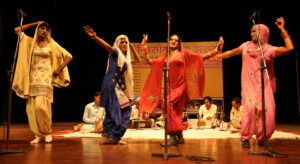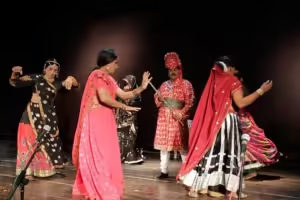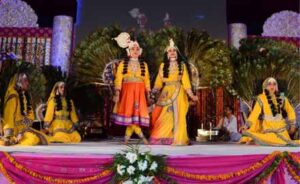Currently Empty: ₹0.00
Drama & Theatre
Theatre of Hariyana: Hariyana Folk Theatre

Haryana is a northern Indian state with a strong, agriculture-based economy and rich cultural heritage. What is important to know about Haryana is that a remarkably exuberant tradition of theatre prevails. Like the other counterparts in Indian folk theatre, it is mainly dipped in rural mythology, folk-lore, and social mores of that particular region. Essentially over time, theatre in Haryana evolved out of these roots and moved to modern and contemporary forms, reflecting shifting societal dynamics yet retaining its core.
However, in this article, variegated forms of folk theatres are examined in Haryana, the influence of modern theatre leading people to influence its growth, and the themes most popular with the audience.
Origin and History of Haryana Theater
The theatre in Haryana, like the rest of rural India, is rooted in religious ceremonies and folk performances. In the olden days, performances traditionally occurred during festivals, marriages, and other significant occasions for the dual purpose of entertainment and social education. Such performances normally took place in public open spaces with the least props and staging possible but with much reliance on music, dance, and improvisation in narrating the story.
Since Haryana falls proximate to Delhi and Punjab, there are bound to be theatres here leading to a very interesting confluence of cultural and artistic exchange. Even with modern theatres emerging, folk theatre still forms an important part of the countryside of Haryana.
Folk Theatre Traditions of Haryana
The folk theatre of Haryana has its great roots in the rural culture of the state. It is based on performances in relation to religious grounds, historical events, social concepts, etc. Some most famous folk theatres of Haryana are Swang, Ragini, Nautanki, and Raas Leela.
- Saang: The Heart of Haryanvi Folk Theatre
Saang is probably one of the most popular and long-lasting forms of folk theatre in Haryana. Name-wise, it is derived from Hindi for imitation or mimicry-“saang.” Saang is a performance form comprising drama, music, dance, and even mimicry to tell some story, mostly moralistic or social.

Characteristics of Saang :
It is, in essence, story-telling but with the use of music and poetry. Raginis – traditional folk songs – are sung in performance using some sort of musical instrument, usually a harmonium, dholak, or sarangi.
Dialogues and Improvisations: Most of the dialogues in Saang are impromptu; the artists draw heavily from the responses of audiences to incorporate humor and local color. This immediacy in the act maintains the interest and life element and mostly blurs the distinction between actors and spectators.
Social Commentary: As much fun as the performances would be, Saang also seriously dealt with gender roles, caste discrimination, and corruption. Most of the time, the performances are didactic in nature, intending to educate as they entertain.
All of the Swang is performed by all-male troupes, where women’s parts are also taken by men, and by mixed troupes. However, now, with its genesis in the Haryana countryside, Saang today integrates ideas and performances related to urban themes as well.
- Nautanki: The Beloved Popular Street Theatre
Nautanki is a popular folk theatre from the northern part of India, specifically in Haryana. It is perceived as a performing art that involves spirited storytelling, vibrant costumes, and melodious songs. Coming up in Uttar Pradesh, Nautanki quickly spread to neighboring regions, including Haryana, where it adapted very well to local sensibilities.

Key Features of Nautanki:
The performance of Nautanki primarily involves the enactment of historical, mythological, and romantic events in a sensational and exaggerated manner. This performance is energetic since it’s highly interactive—the performers would even be able to address the audience directly.
While the costuming and setting in terms of color becomes so elaborate in Nautanki, they’re very minimalistic in Swang. The actors are bright with their traditional costumes, and performances in either place are conducted mostly in temporary structures or open places with different makeshift settings.
Music and Dance: Much like Swang, music forms an essential part of Nautanki. It makes use of a dholak, harmonium, and tabla—traditional instruments. The songs are very peppy, while the rhythmic dances add up to the total spectacle.
Nautanki is the most popular form of Haryana, depicting basically the cultural and social ethos of the region through stories in voices echoing among the rural masses. Tales of love, valour, and justice have been portrayed most commonly with a mixture of humor and tragedy.
- Raas Leela: The Devotional Theatre
Raas Leela basically is a form of theater performance undertaken on special days in relation to religious celebrations, particularly those related to Lord Krishna. Though the very name of Raas Leela is associated with the Braj region of Uttar Pradesh, it also happens to be a popular art in Haryana, especially its districts bordering Uttar Pradesh.

Key Highlights of Raas Leela
Mythological Themes: Raas Leela is enacted on various themes taken from the life of Lord Krishna, mainly in his childhood and youth. The most famous Raas Leela stories relate to those regarding the playfulness of Krishna with the gopis and his divine love for Radha.
It derives the name from the dance that forms an integral part of Raas Leela. Performances contain traditional devotional songs and bhajans in any form; dancers perform acts about Krishna, Radha, and other characters of Hindu mythology.
Ritualistic element: Raas Leela is an event passed in time, yet it is a spent event. It is as though entranced, that the performers themselves offer these performances to Lord Krishna, enacting scenes of worshipping him.
Through Raas Leela, the very core of spiritual life is breathed into Haryana, and it finds most enactments within the premises of a temple or at some other religious festival like Janmashtami. Of course, devotional by nature, is more a function than anything else since communities gather to celebrate their shared beliefs.
Modern Theatre of Haryana
Their typical forms of theater and Nautanki-are still flourished in the countryside, though even modern theater has picked up in the recent times in urban Haryana through its hubs of Gurgaon, Faridabad, and Panipat. The modern-day theatre in the Haryanvi language usually focuses on issues related to migration, urbanization, gender equality, and ecological concerns.
- Establishment of Institutions for Theatre The Haryana Modern Theatre has been encouraged through various theatre groups and institutions. In this respect, the most outstanding among them is the Haryana Kala Parishad, which besides promoting traditional folk performing arts, encourages modern theatre. Much of the inspiration for the theatre activists of the Haryanvi Theatre has come from the National School of Drama, New Delhi, whereby one gets formal training and finds a place in the open theatre.
The modern theatre movement in Hysana gained impetus with recent theatre festivals like Rang Mahotsav. In this regard, many new playwrights and directors of socially relevant works found a dais to present their creations in front of large and diverse audiences.
- Modern Themes in Haryanvi Theatre Migration and Urbanization: Rapid urbanization of Haryana and, particularly, places like Gurgaon have made migration one of the major themes of modern Haryanvi theatre, wherein lies the emotional and cultural displacements that face rural families while shifting to cities. The way the plays describe the struggles faced in trying to adjust to urban life is along with the bonds toward rural traditions. Empowerment of women is one current issue that modern theatre in Hadyara mainly handles. Most of the plays are concerned with women and their education, domestic violence, and the change in the position of women with the gender equality movement happening in the state. Caste and Social Hierarchy: Criticism of deeply entrenched caste systems in Haryana can be seen repeatedly in contemporary theatre. Playwrights have focused more in recent years on caste-based discrimination, honor killings, and the struggle of marginalized communities. Influences of Great Personalities There were a few stalwarts in the development of theater in Haryana. Pandit Lakhmi Chand was considered as the “Shakespeare of Haryana” and remained a very popular folk poet and playwright, who contributed much towards the swang tradition. A mixture of folk wisdom, comedy, and social criticism makes his works always popular for the theatre circuits in Haryana. The other potent name is that of the contemporary playwright and director, Uday Bhanu Hans, whose dramatization brought many problems relating to the contemporary context into focus. His plays often dwell on tradition, more particularly the cultural alteration in Haryana due to modernity. Theater in Haryana is a blossoming expression of the variability in culture and social milieu that surrounds the state. Be it the ironic comic settings of Swang to the reverential expressions of Raas Leela; there is something about the life here that makes theatres of Haryana unique. Though modern theatre introduced new themes and forms into Haryanvi theatre, essentially it is rooted in the bond with the land, the people, and their stories. In the same way, while Haryana marches ahead to increased urbanization, its theatre stands today as a strong medium for upholding tradition as well as voicing the relevant social concerns of today.




